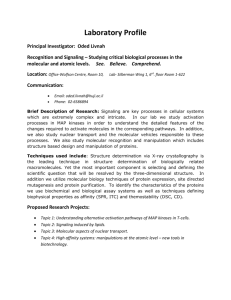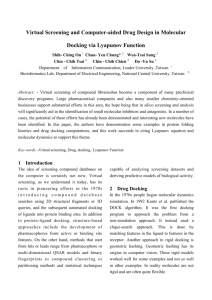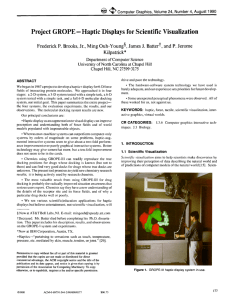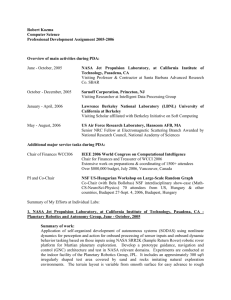Haptic Influences on Reasoning and Learning in Protein Education
advertisement
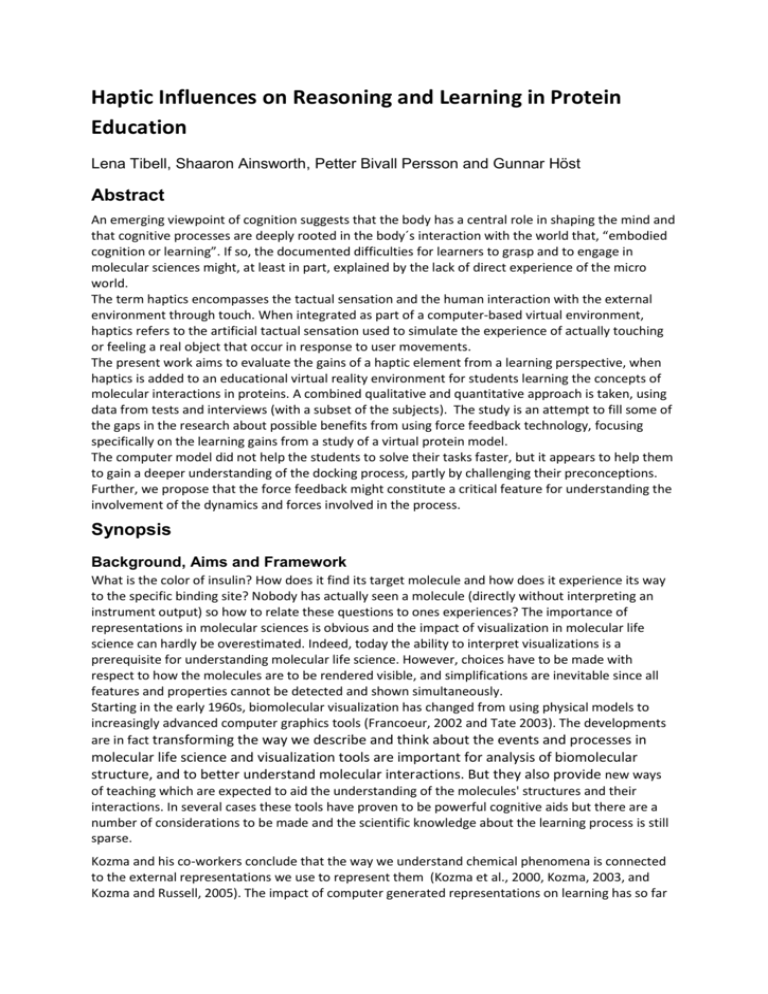
Haptic Influences on Reasoning and Learning in Protein Education Lena Tibell, Shaaron Ainsworth, Petter Bivall Persson and Gunnar Höst Abstract An emerging viewpoint of cognition suggests that the body has a central role in shaping the mind and that cognitive processes are deeply rooted in the body´s interaction with the world that, “embodied cognition or learning”. If so, the documented difficulties for learners to grasp and to engage in molecular sciences might, at least in part, explained by the lack of direct experience of the micro world. The term haptics encompasses the tactual sensation and the human interaction with the external environment through touch. When integrated as part of a computer-based virtual environment, haptics refers to the artificial tactual sensation used to simulate the experience of actually touching or feeling a real object that occur in response to user movements. The present work aims to evaluate the gains of a haptic element from a learning perspective, when haptics is added to an educational virtual reality environment for students learning the concepts of molecular interactions in proteins. A combined qualitative and quantitative approach is taken, using data from tests and interviews (with a subset of the subjects). The study is an attempt to fill some of the gaps in the research about possible benefits from using force feedback technology, focusing specifically on the learning gains from a study of a virtual protein model. The computer model did not help the students to solve their tasks faster, but it appears to help them to gain a deeper understanding of the docking process, partly by challenging their preconceptions. Further, we propose that the force feedback might constitute a critical feature for understanding the involvement of the dynamics and forces involved in the process. Synopsis Background, Aims and Framework What is the color of insulin? How does it find its target molecule and how does it experience its way to the specific binding site? Nobody has actually seen a molecule (directly without interpreting an instrument output) so how to relate these questions to ones experiences? The importance of representations in molecular sciences is obvious and the impact of visualization in molecular life science can hardly be overestimated. Indeed, today the ability to interpret visualizations is a prerequisite for understanding molecular life science. However, choices have to be made with respect to how the molecules are to be rendered visible, and simplifications are inevitable since all features and properties cannot be detected and shown simultaneously. Starting in the early 1960s, biomolecular visualization has changed from using physical models to increasingly advanced computer graphics tools (Francoeur, 2002 and Tate 2003). The developments are in fact transforming the way we describe and think about the events and processes in molecular life science and visualization tools are important for analysis of biomolecular structure, and to better understand molecular interactions. But they also provide new ways of teaching which are expected to aid the understanding of the molecules' structures and their interactions. In several cases these tools have proven to be powerful cognitive aids but there are a number of considerations to be made and the scientific knowledge about the learning process is still sparse. Kozma and his co-workers conclude that the way we understand chemical phenomena is connected to the external representations we use to represent them (Kozma et al., 2000, Kozma, 2003, and Kozma and Russell, 2005). The impact of computer generated representations on learning has so far mostly concerned visual representations. Haptic technology refers to technology which interfaces the user via the sense of touch by applying forces, vibrations and/or motions to the user. While visuals can convey information in a more rapid and encompassing way, helping in the perception of larger (macro) structures, haptics is often superior when investigating smaller (micro) geometric properties (Lederman, 1983; Zangaladze, et al., 1999). In some contexts, the combination of the two senses can be superior to either alone and the ability to use kinaesthetics may help in grasping concepts concerning physical phenomena (Insko, et al., 2001). In the research that has been carried out to investigate the area of using haptics in educational settings, the use of force feedback appear to ease the understanding of a variety of complex processes. In particular gains are shown when dealing with cases that include elements of forces we handle regularly (such as in mechanics) or when there exists an intuitive translation from the studied phenomenon into force for example. In the work of Reiner (Reiner, 1999) it was shown that after using a simple tactile interface to a computer program, students developed a concept of fields and constructed representations close to those of formal physics. Haptics can enable a user to feel intermolecular forces or even subatomic structures, such as the electron density function, through a force representation. Using haptics and force feedback, physical interaction can be reintroduced, but this time the interaction is with computer models rather than physical models. In contrast to the original physical models, force feedback allows the model to mediate intermolecular forces, attractive as well as repulsive, experienced by ligands. This technique is used in the Chemical Force Feedback (CFF) system, developed by us. The overall aim of the study is to investigate if the haptic modality of the computer model can promote a deeper understanding of the factors and processes involved in the process of docking a small molecule to a protein. This is a process where students have considerable difficulties to connect their knowledge to a coherent whole. More specifically, does haptics affect a) what they learn and b) how they learn? Methods, Sample and Research design The subjects in the investigation were students taking the course “Biomolecular interactions” which are part of the masters program in Chemical biology at Linköping University. This course focuses biomolecular structures and interactions, in particular interactions between proteins and ligands and also gives a thermodynamic background to factors determining structure recognition (how for example a drug molecule recognize and binds to its target protein). The goal is to give the students an understanding of the dynamics of molecular exchange. In order to achieve this level of understanding they have to get a deep understanding of concepts and processes determining molecular docking and to recognize the chemical and sterical constrains, the dynamics of molecular systems, the stochastic character of the process, exchange processes, intermolecular dynamics between protein and ligand and intra molecular dynamics in the protein, and the relations between affinity and kinetics and their correlation to binding energy. Twenty students (8 women and 12 men) participated in the study. The students were divided into two groups using an initial domain test. The aim was to get an even gender and achievement level distribution between the groups. Both aims were attained with an average score on the initial domain test of 44 and 48 for the test and reference groups, respectively, and a gender distribution of 6 men and 4 women in both the test and reference groups. The studies were focused around a computer laboratory using the CFF-system as a thinking tool to investigate the docking between a protein (Carbonic anhydrase) and a set of ligands. The aim was to find the best docking for each ligand, each ligand producing a different affinity to the enzyme. The tool was used with different conditions for the force feedback element. One group of students, the test group (H) performed the task with force feedback enabled, whereas the other group (NH) had force feedback disabled. Performing the computer lab was a compulsory element in the course, while participating in the research was voluntary. The study followed a classic test-reference group design. Data were collected before and after (surveys, pre- and post-tests, and interviews) and during (task responses and dock files) the computer lab was carried out. The pre-and post-tests were given in immediate connection to the tasks. These tests were designed to enable an estimate of the potential cognitive gain from the use of the haptic representation; estimated after applying statistical analysis. The performance (answers on questions) on the tasks was graded and the docking performance assessed from saved results from the students’ dockings (dock files). The pre- and post-tests also included open ended questions and these, together with the students’ written answers to the tasks, were analyzed for scientific content, depth of understanding and a linguistic analysis of type of reasoning (see below). Results and Conclusions A significant effect on learning (learning gain) was observed after the computer-lab session for both the H- and the NH-group (F(1,18) = 4.76, MSE = 9.01, p<0.05) (Figure 1). However, a strong trend indicated that the students using the haptic devise (H) learned more (F(1,18) =3.773, MSE = 15.93, p<0.07). 22 Haptics No Haptics 20 18 16 14 12 10 pre-test post-test Figure 1. Overall scores (Y-axes) on pre- and post test. Not unexpectedly, the students who knew more about the process of ligand docking at the pre-test docked their ligand more successfully. The main finding, however, are to be seen in the qualitative analysis of the written responses on worksheets and the open questions on pre- and post-tests. When analyzing the students’ verbal resources while reasoning, five categories (semantic fields) emerged, here referred to as steric-, chemical-, force-, dynamic and energy (Table 1). The reasoning in the pre-test responses is dominated by chemical and steric reasoning while the use of force and energy expressions is rare. In the post-test there is no main change in the reasoning pattern compared to the pre-test for the students who have used the tool without force-feedback (NHgroup). The use of steric reasoning appears to be more independent of the force-feedback experience. However, the students who have experienced the force-feedback (H) appear to use expressions from the force category much more frequently and decrease their use of expressions in the chemistry category in their reasoning. The number of words in the energy category is relatively few which make the interpretation hard. The corresponding analysis of the use of words and expressions in the task responses revealed a similar pattern (data not shown). Table 1. The distribution of words (in %) between five different semantic fields (chemical, steric, dynamics, forces and energy). Test Condition Chem Steric Dynamics Forces Energy 40 32 18 8 3 H 21 21 17 35 6 NH 48 26 11 7 7 Pre Post Analysis of the students’ comments in their written questionnaires revealed two major points; 1. the tool with force-feedback was valued higher than the one without by almost all students. By giving the students feedback it helped them to find the docking position and guided their reasoning. 2. a frustration due to challenged preconceptions. Several of the students complained over the bumping and shaking of the ligand when they tried to dock it, and some wanted to be guided to the correct docking position and was disappointed that they had to use chemical knowledge and combine it with the tactile experience. In summary, the computer model appears to help the students to gain a deeper understanding of the docking process, partly by challenging their preconceptions. Further, we propose that the force feedback might constitute a critical feature for understanding the involvement of the dynamics and the forces involved in the process. Bibliography Bivall Persson, P., Cooper, M.D., Jonsson, B.H. , Ynnerman, A., Ainsworth, S. & Tibell, L.A.E. , (2007) Designing and evaluating a haptic system for biomolecular education, Proceedings of IEEE virtual reality 2007, 171-178. Francoeur, E., (2002) Cyrus Levinthal, the Kluge and the origins of interactive molecular graphics, Endeavour, 26, 127-131. Insko, B., Meehan, M., Whitton, M., & Brooks, F. (2001) Passive haptics significantly enhances virtual environments. Computer Science Technical Report 01-010, University of North Carolina, Chapel Hill, NC. Kozma, R., Chin, E., Russell, J., & Marx, N. (2000) The Roles of Representations and Tools in the Chemistry Laboratory and Their Implications for Chemistry Learning. The Journal of the Learning Sciences., 9, 2, 105-143. Kozma, R. (2003) The material features of multiple representations and their cognitive and social affordances for science understanding. Learning and Instruction, 13, 2, 205-226. Lederman, S. (1983) Tactile roughness perception: Spatial and temporal determinants. Canadian Journal of Psychology, 37, 498-511. Kozma, R., & Russell, J. (2005) Students becoming chemists: developing representational competence. In J. Gilbert (Ed) “Visualization in Science Education”, Springer, Ort Dordrecht, 121146. Reiner, M. (1999) Conceptual Construction of Fields Through Tactile Interface. Interactive Learning Environments, 7, 31-55. Tate, J. (2003) Molecular visualization, Methods in Biochem. Anal., 44, 135-158. Zangaladze, A., Epstein, C., Grafton, S.,& Sathian, K. (1999) Involvement of visual cortex in tactile discrimination of orientation. Nature, 401, 587-590.







